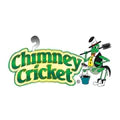Why Clean Chimneys ?
When wood burns, it gives off volatile gases. These gases cool and condense as they travel up the chimney, forming creosote. With subsequent use, the creosote is reheated and can ignite, causing a fire up inside the chimney. In 1978 some 40,000 chimney fires in the U.S. caused $23 million in damage.Creosote build-up varies with the type of burner used, type of wood burned and how the fireplace or stove is operated. Woodburning stoves, because of their high energy efficiency, form a quicker build-up than traditional fireplaces. Softwood, such as pine or cedar, produce more creosote than hardwoods, like oak or birch. Slower burning fires result in more creosote. Build-up can be reduced by operating your fireplace at high volume for a short time at the beginning and end of use.
Does My Chimney Needs to be Cleaned?
Chimney flues should be inspected annually. The chimney needs cleaning if bricks appear black or "furry". Some chimney's which have not yet been cleaned often enough may have become glazed. These chimneys cannot be cleaned using a standard brush, and require expensive chemical treatment. Besides being expensive they become a dangerous risk to a chimney fire. The chimney should not be used until glazing is removed.
Why Clean Your Chimney?
According to fire officials, 98% of all chimney fires are caused by a build-up of creosote. When burning wood or artificial logs they give off volatile gases. These gases cool and condense forming creosote as they travel up your chimney.
Inserts and wood stoves from creosote build-up much faster due to their high energy efficiency. Softwoods also produce much more creosote.
With continued use, creosote can ignite causing a fire up inside the chimney. Local fire departments receive half a dozen calls monthly concerning chimney fires.
Two dangers lie in chimney fires. One is the chimney fire itself and secondly if there are cracks in the chimney wall. This could cause it to spread to the rest of the house.
Fire officials suggest an annual safety inspection. This inspection should check both build-ups of creosote and for any possible cracks or loose bricks. The chimney needs cleaning if bricks appear black or "furry".
Some chimneys which have not been cleaned often enough may have become glazed. These chimneys cannot be cleaned using a standard brush, and require expensive chemical treatment. Besides being expensive, they become a dangerous risk to a chimney fire. The chimney should not be used until glazing is removed.
THE RULES OF THUMB ARE:
• Annual cleanings for those frequently used: 4-5 times per week.
• Semi-annual cleanings for occasional use.
• Cleanings every 3-7 years for special-occasions usage. When in doubt, inspect yourself or get a professional opinion.
How Is A Chimney Cleaned?
The sweep lays down a protective covering around the hearth area. He then opens up the damper and slides a brush up and down the chimney flue until clean. Then, with a smaller brush, cleans the smoke shelf, damper, and firebox.
Our chimney sweeps will perform the following steps in cleaning your chimney:
- Clean the chimney flue from top to bottom.
- Clean the smoke shelf, damper, and firebox.
- Perform a 21 point safety inspection – inside the chimney and out. This inspection will allow our chimney sweeps to make recommendations in order to satisfy code, ensure the safety of you and your family, and prevent extensive and expensive damages to your chimney and home.
- Deodorize the chimney. Note: If you have glass doors, we have a special process to make them look new.
- Lay a protective covering around the hearth area.
